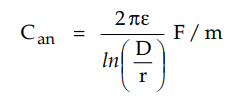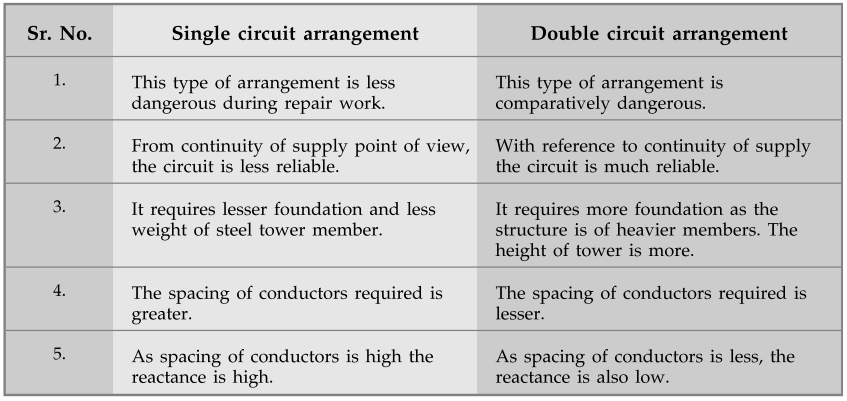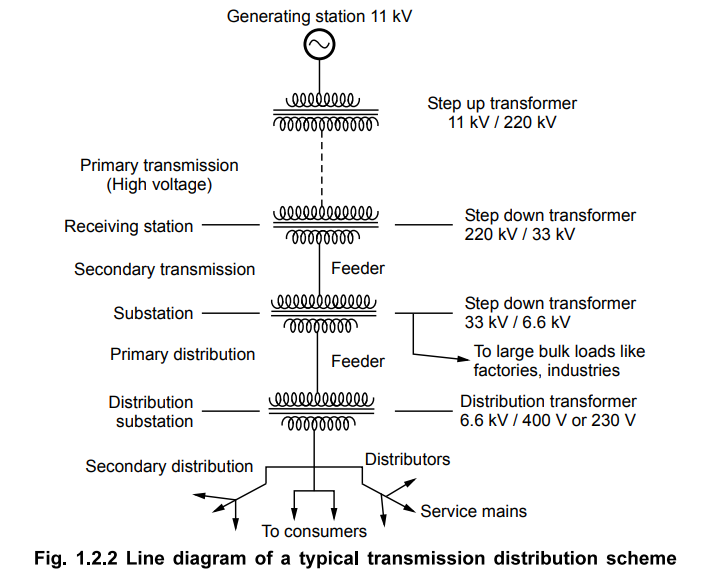Transmission and Distribution: Unit I: Transmission Line Parameters
Two Marks Questions with Answers
Transmission and Distribution | Transmission Line Parameters
Transmission and Distribution: Unit I: Transmission Line Parameters : Two Marks Questions with Answers
Two Marks Questions with
Answers
Q.1 What is meant by stranded conductors
?
Ans. : A stranded conductor is defined as the
conductor which is composed of a group of wires or a combination of groups of
wires which are electrically parallel, usually twisted together possessing
greater flexibility and providing higher mechanical strength.
Q.2 Define transposition in transmission
line.
Ans. : Transposition
is the periodic swapping of positions of the conductors of a transmission line,
so that each conductor occupies the original position of every other conductor
over an equal distance so as to achieve balance in the three phases.
Q.3 What is skin effect and what is its
consequence ?
Ans. : Skin
effect is defined as the tendency for the Alternating Current (AC) to flow
mostly near the outer surface of a conductor which causes non-uniform
distribution of current. Thus the current density is largest near the surface
of the conductor and decreases with greater depths inside the conductor. The
effect becomes more and more apparent as the frequency increases.
Due to reduction in effective area of
cross section offered to the flow of current through the conductor, the
resistance of conductor increases.
Q.4 State two advantages of bundled
conductors ?
Ans. : The advantages
of bundled conductors are
i) Reduction in corona loss.
ii) Minimization of interference with
communication circuit.
iii) Reduction in voltage drop which
increases circuit capacity and boosting of operating voltage.
iv) Low reactance, increase in
capacitance and surge impedance loading.
Q.5 Differentiate between bundled
conductors and stranded conductors. Ans. :

Q.6 Define the term "Interference
with neighboring circuits".
Ans. : The
power lines and communication lines run along the same path or even run on same
support s along the same route. The transmission lines transmit bulk power with
relatively high voltage and produce electromagnetic and electrostatic fields of
appreciable magnitudes. Because of these fields, voltages and currents are
induced in the neighboring communication line causing distortion in the line
which is known as interference of power lines with neighboring communication
circuits.
Q.7 Write the expression for capacitance
of the 3 phase unsymmetrically spaced transmission lines.
Ans. : The capacitance of the 3 phase
unsymmetrically spaced transmission lines is given by,

Q.8 On which factors does proximity
effect depends ?
Ans. : The proximity
effect depends on following factors
i) Frequency of the current. ii) Resistivity of the conductor material,
iii) Shape of the conductor. iv) Diameter of the conductor.
Q.9 State the advantages of ACSR
conductors when used for overhead lines.
Ans. : The advantages
of ACSR conductors when used for overhead lines are,
i) Due to high mechanical and tensile
strength, the line span can be increased. Since the sag is small, shorter
supports are required for line.
ii) Low corona loss.
iii) Less skin effect.
iv) The conductors are inexpensive as
compared to copper conductors.
Q.10 What is the effect of bundled
conductors on the transmission line inductance?
Ans : The inductance
of a bundled conductor is given by,

where x is number of subconductors in
each bundle.
Thus with increase in number of
subconductors in each bundle, there is corresponding increase in Ds
which in effect reduces the inductance of the transmission line due to which
inductive reactance is also lowered.
Q.11 Briefly explain ACSR.
Ans. : ACSR
stands for Aluminium Conductor with Steel Reinforcement where the mechanical
strength of the conductor is increased by adding steel core to the conductor.
The central core is made up of steel which is surrounded by aluminium
conductors in suitable layers. For a given resistance, conductors of different
strengths can be made by taking different properties of steel and aluminium
areas. The steel core does not contribute to conduction of current practically.
The current capacity and resistance of this conductor is dependent on
conductivity of aluminium. The advantages of ACSR conductors are high
mechanical strength, low corona loss, lower skin effect and inexpensive as
compared with copper conductors.
Q.12 State the expression for loop
inductance of a single phase line.
Ans. : The
expression for the loop inductance of a conductor with spacing D between the
conductors and r' as the effective radius (GMR) is given by
4 × 10-7 ln D / r’
Q.13 What is proximity effect ? What is
its consequence ?
Ans. : Due to non uniform distribution of
current, the current density is non uniform which increases the effective
resistance of the conductor. As the distance between the conductors goes on
reducing, the distribution of current becomes more and more non uniform. This
is known as proximity effect. Thus in a conductor carrying alternating current,
if currents are flowing through one or more other nearby conductors, the
distribution of current within the first conductor will be constrained to smaller regions which results in current
crowding. This effect of current crowding is known as proximity effect which
increases the effective resistance of the circuit and increases with frequency.
Q.14 On which factors does skin effect
depends ?
Ans. : The skin effect
depends on following factors
i) Frequency of the current. ii) Resistivity of the conductor material,
iii) Shape of the conductor. iv) Diameter of the conductor.
Q.15 What is bundling of conductors ?
Ans. : The bundling of conductors is nothing
but the formation of two or more subconductors in specific geometric configuration
with certain constant distance within them for transmission of bulk power so as
to reduce corona loss, line reactance and radio interference.
Q.16 Write the expression for
capacitance of a single phase overhead transmission line.
Ans. : The
capacitance of single phase overhead transmission line between the conductors
having radius r and separated by a distance D is given by,

whereas capacitance of single phase
overhead transmission line between one of the conductors and the neutral is
given by,

Q.17 Why is skin effect absent in dc
system 7
Ans. : When
dc current flows in the conductor, it distributes equally and uniformly inner
and outer whereas in the case of ac, higher current flows in outer surface and
lower in inner surface due to which the resistance increases in inner surface.
Thus due to uniform distribution of current in dc system through the cross
section of conductor, skin effect is absent.
Q.18 Why transmission lines are 3 phase
3 wire circuits while distribution lines 3 phase 4 wire circuits ?
Ans. : For distribution of electrical power,
3 phase 4 wire circuits are used so as to supply single phase and three phase
loads depending on the requirement. While for transmission, power is not
supplied to load, but only carried from generating stations towards
distribution. So 4th wire i.e. neutral wire is not required so 3 phase 3 wire
circuits are used.
Q.19 A 3 phase transmission line has its
conductor at the corners of an equilateral triangle with side 3 m. The diameter
of each conductor is 1.63 cm. Find the inductance per km per phase of the line.
Ans. : The
expression for the inductance of a conductor A in a three phase line with
spacing D between the conductors and r' as the effective radius (GMR) is given
by

Q.20 What are the advantages of double
circuit lines.
Ans. : The advantages
of double circuit lines are
i) Continuity of supply is possible.
ii) More reliable.
iii) Less spacing of conductors
required.
iv) Less inductance and reactance.
Efficiency is enhanced as compared with single circuit lines.
Q.21 State the factors on which the
inductance of a line is dependent.
Ans. : The factors on
which the inductance of a line is dependent are
i) Radius of the conductor.
ii) Spacing between the conductors.
Q.22 What do you mean by neutral plane.
Ans. : A neutral plane is defined as the
plane that exists at midway between the two long, parallel and oppositely
charged conductors where the electric potential and electric field intensity is
zero.
Q.23 What are the parameters associated
with a transmission line.
Ans. : The parameters
associated with a transmission line are
i) Resistance
ii) Inductance
iii) Capacitance
iv) Conductance between the conductors
or between conductors and ground which is very small and often neglected.
Q.24 What are the various types of
aluminium conductors.
Ans. : The various
types of aluminium conductors are
i) AAC All Aluminium Conductor.
ii) AAAC All Aluminium Alloy Conductor.
iii) ACSR Aluminium Conductor with Steel
Reinforcement.
iv) ACAR Aluminium Conductor with Alloy
Reinforcement.
Q.25 What do you mean by inductance of a
line.
Ans. : Inductance of a line is defined as the
property of a conductors in the line by which a change in current flowing through
it induces a voltage in both the conductors as well as in any nearby
conductors. Its unit is Henry (H).
Q.26 What do you mean by symmetrical
spacing of a line.
Ans. : When
the distance between the various conductors of the three phase line is same then
the line is said to have symmetrical spacing.
Q.27 State the advantages of aluminium
conductors when used for overhead lines.
Ans. : The advantages
of aluminium conductors when used for overhead lines are,
i) Low cost ii) Less resistance
iii) Low corona loss iv) Less weight
Q.28 What do you mean by unsymmetrical
spacing of a line.
Ans. : When the distance between the various
conductors of the three phase line is different then the line is said to have
symmetrical spacing.
Q.29 What are the factors to be
considered while designing a transmission line.
Ans. : The various
factors to be considered while designing a transmission line are
i) Type and size of conductor.
ii) Voltage level.
iii) Power flow capability, stability
and efficiency of transmission.
iv) Line regulation and control of
voltage.
v) Power system structure.
vi) Economic aspects.
Q.30 What are the various factors
influencing telephone interference ?
Ans. : The various
factors influencing telephone interference are
i) Harmonics in power circuits, their
frequency and magnitudes.
ii) Electromagnetic coupling between
power and telephone conductor.
iii) Due to imbalance in power and
telephone circuits.
iv) Type of return telephone circuit
i.e. metallic or ground return.
v) Screening effects.
Q.31 What are the various ways for
reducing telephone interference ?
Ans. : The steps for
reducing telephone interference are
i) The harmonics at the source can be
reduced with AC and DC harmonic filters and smoothening reactors.
ii) Greater spacing between power and
telephone lines.
iii) Parallel run between power and
telephone line is avoided.
iv) Underground lines for telephones can
be used.
v) If telephone circuit is ground return
then replace it with metallic return.
Q.32 State the factors on which electrostatic
and electromagnetic effects depend.
Ans. : The main factors on which
electrostatic and electromagnetic effects depend are the distance between power
and communication circuits and the length of the route over which they are
parallel.
Q.33 What do you mean by symmetrical and
unsymmetrical spacing ?
Ans. : If
the conductors are placed equidistant from each other they are said to be symmetrically
spaced e.g. conductors placed at the comers of an equilateral triangle.
If the conductors are not placed equidistant
from each other but the distance between the conductors is different from each
other they are said to be unsymmetrically spaced e.g. conductors placed in a
horizontal or vertical plane.
Q.34 Compare between single and double
circuit arrangement.
Ans. : The comparison
between single and double circuit arrangement is given below.

Q.35 Define electrical supply system.
Ans. : The flow of
electrical power from the generating station to the consumer is called an
electrical supply system. It consists of following components :
i) Generating station ii) Transmission
network and iii) Distribution network
Q.36 State the practical transmission
and distribution voltage levels commonly used.
Ans. : Generating stations
: 6.6 kV, 11 kV or 22 kV.
Primary transmission
: 66 kV / 132 kV / 220 kV / 400 kV.
Secondary transmission :
11 kV / 22 kV / 33 kV.
Primary distribution :
6.6 kV / 3.3 kV / 11 kV.
Secondary distribution :
400 V / 230 V.
Q.37 What is single line diagram ?
Ans. : The
single line diagram is the simplified representation of power system components
with each other, with each component represented by its symbol.
Q.38 List the various elements of power
system.
Ans. : The various
elements of power system are generators, transformers, transmission lines, bus
bars, circuit breakers, isolating switches, feeders, distributors, service
mains etc.
Q.39 What is bulk power supply system ?
Ans. : The generating
stations at which power is generated at 11 kV and the transmission lines used
to transfer power by stepping up the voltage level to very high level are often
called bulk power supply system.
Q.40 What is feeder ?
Ans. : The
feeders are the conductors which are of large current carrying capacity. The
feeders connect the substation to the area where power is to be finally
distributed to the consumers.
Q.41 What is service mains ?
Ans. : The small
cables used to connect the distributors and the actual consumer premises are
called service mains.
Q.42 Draw a single line diagram of a modern
electric power system.
Ans. :

Q.43 What is a distributor ?
Ans. : A distributor
is a conductor which is used to distribute an electrical power from the
substations to the consumers.
Q.44 Why the concept of self GMD is not
applicable for capacitance calculation ?
AU : Dec.-17
Ans. : The
concept of self GMD depends on the size and shape of the conductor i.e. radius
of conductor and not on the spacing between the conductors. While capacitance
depends on the spacing between the conductors. Hence the concept of self GMD is
not applicable for capacitance calculations.
Q.45 What is transposition ? Why are
transmission line transposed ?
AU : Dec.-17
Ans. : The positions of the conductors are
exchanged at regular interval along the line so that each conductor occupies
the original position of every other conductor over an equal distance. This
exchange of conductor positions is called transposition
The advantages of transposition are,
i) The balance in three phases is
restored.
ii) The inductance and capacitance of
conductors are equal.
iii) It reduces the possibility of
acoustic shock or noise.
iv) It stabilizes the voltage unbalance.
v) It reduces the effect of inductive
coupling and imbalanced currents.
vi) Reduces cross-talks and improves the
overall transmission.
Q.46 Distinguish between a feeder and a
distributor 7
Ans. : The feeders connect the substation to
the distribution centre while the
distributors are the conductors, which
are used to transfer power from distribution centre to the consumers. The
feeders have large current carrying capacity than distributors. The tappings
are taken for the supply to the consumers from distributors but no tappings are
taken from the feeders.
Q.47 Distinguish between self and mutual
GMD.
Ans. : The
distance of filament of conductor from itself is called self Geometrical Mean
Distance i.e. self GMD. It is also called Geometric Mean Radius (GMR). It
depends on the size and shape of he conductor and not on the spacing between
the conductors. The mutual GMD is defined as the geometrical mean of the
distances from one conductor to the others. It represents equivalent
geometrical spacing.
Transmission and Distribution: Unit I: Transmission Line Parameters : Tag: : Transmission and Distribution | Transmission Line Parameters - Two Marks Questions with Answers
Related Topics
Related Subjects
Transmission and Distribution
EE3401 TD 4th Semester EEE Dept | 2021 Regulation | 4th Semester EEE Dept 2021 Regulation
